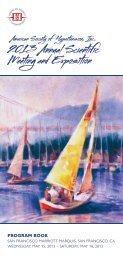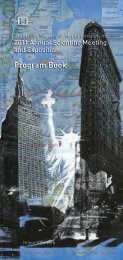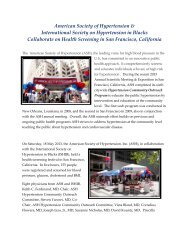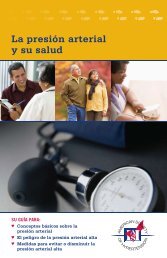2010 Annual Scientific Meeting and Exposition 2010 Annual ...
2010 Annual Scientific Meeting and Exposition 2010 Annual ...
2010 Annual Scientific Meeting and Exposition 2010 Annual ...
Create successful ePaper yourself
Turn your PDF publications into a flip-book with our unique Google optimized e-Paper software.
een reported. In a 4-day trial of valsartan in 12 hypertensive patients with unilateralrenal artery stenosis, no significant increases in serum creatinine or bloodurea nitrogen were observed. There has been no long-term use of valsartan inpatients with unilateral or bilateral renal artery stenosis, but an effect similar tothat seen with ACE inhibitors should be anticipated.5.9 CyclosporineAliskirenWhen aliskiren was given with cyclosporine, the blood concentrations of aliskirenwere significantly increased. Concomitant use of aliskiren with cyclosporine isnot recommended [see Drug Interactions (7)].6 ADVERSE REACTIONS6.1 Clinical Studies ExperienceThe following serious adverse reactions are discussed in greater detail in othersections of the label:• Risk of fetal/neonatal morbidity <strong>and</strong> mortality [see Warnings <strong>and</strong> Precautions(5.1)]• Head <strong>and</strong> neck angioedema [see Warnings <strong>and</strong> Precautions (5.2)]• Hypotension [see Warnings <strong>and</strong> Precautions (5.3)]Because clinical trials are conducted under widely varying conditions, adversereaction rates observed in the clinical trials of a drug cannot be directly comparedto rates in clinical trials of another drug <strong>and</strong> may not reflect the ratesobserved in practice.ValturnaValturna has been evaluated for safety in more than 1,225 patients, includingover 316 patients for over 1 year. In placebo-controlled clinical trials, discontinuationof therapy because of a clinical adverse event (including uncontrolledhypertension) occurred in 1.4% of patients treated with Valturna versus 2.7%of patients given placebo.Adverse events in placebo-controlled trials that occurred in at least 1% of patientstreated with Valturna <strong>and</strong> at a higher incidence than placebo included fatigue(2.6% vs. 1.4%), nasopharyngitis (2.6% vs. 2.2%), diarrhea (1.4% vs 0.9%),upper respiratory tract infection (1.4% vs. 1.1%), urinary tract infection (1.4%vs. 0.6%), influenza (1.1% vs 0.2%), <strong>and</strong> vertigo (1.1% vs. 0.3%).Hyperkalemia has been observed as a serum electrolyte abnormality in Valturnaclinical trials [see Warnings <strong>and</strong> Precautions (5.7)].AliskirenAliskiren has been evaluated for safety in 6,460 patients, including 1,740 treatedfor longer than 6 months, <strong>and</strong> 1,250 for longer than 1 year. In placebo-controlledclinical trials, discontinuation of therapy because of a clinical adverse event,including uncontrolled hypertension occurred in 2.2% of patients treated withaliskiren, versus 3.5% of patients given placebo.Two cases of angioedema with respiratory symptoms were reported with aliskirenuse in the clinical studies. Two other cases of periorbital edema without respiratorysymptoms were reported as possible angioedema <strong>and</strong> resulted in discontinuation.The rate of these angioedema cases in the completed studies was 0.06%.In addition, 26 other cases of edema involving the face, h<strong>and</strong>s, or whole bodywere reported with aliskiren use, including 4 leading to discontinuation.In the placebo-controlled studies, however, the incidence of edema involving theface, h<strong>and</strong>s, or whole body was 0.4% with aliskiren compared with 0.5% withplacebo. In a long-term active-controlled study with aliskiren <strong>and</strong> HCTZ arms,the incidence of edema involving the face, h<strong>and</strong>s, or whole body was 0.4% inboth treatment arms.Aliskiren produces dose-related gastrointestinal (GI) adverse reactions. Diarrheawas reported by 2.3% of patients at 300 mg, compared to 1.2% in placebopatients. In women <strong>and</strong> the elderly (age ≥65) increases in diarrhea rates wereevident starting at a dose of 150 mg daily, with rates for these subgroups at150 mg similar to those seen at 300 mg for men or younger patients (all ratesabout 2%). Other GI symptoms included abdominal pain, dyspepsia, <strong>and</strong> gastroesophagealreflux, although increased rates for abdominal pain <strong>and</strong> dyspepsiawere distinguished from placebo only at 600 mg daily. Diarrhea <strong>and</strong> other GIsymptoms were typically mild <strong>and</strong> rarely led to discontinuation.Aliskiren was associated with a slight increase in cough in the placebo-controlledstudies (1.1% for any aliskiren use vs. 0.6% for placebo). In active-controlledtrials with ACE inhibitor (ramipril, lisinopril) arms, the rates of cough for the









